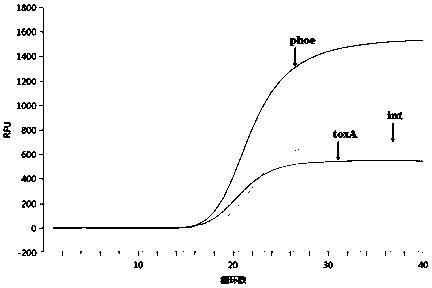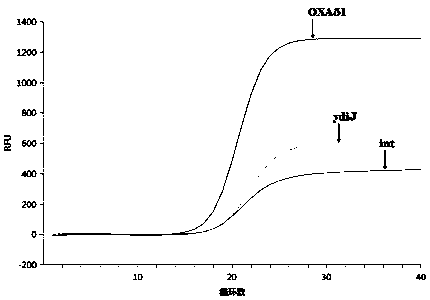Primer and/or probe composition for detecting bacillus for initiating blood flow infection and application of primer and/or probe composition
A composition and probe technology, applied in the field of molecular biology, can solve the problems of decreased patient survival rate, increased cost of bacterial drug resistance treatment, decreased patient survival rate, etc.
- Summary
- Abstract
- Description
- Claims
- Application Information
AI Technical Summary
Problems solved by technology
Method used
Image
Examples
Embodiment 1
[0107] This example provides the composition of exemplary kits.
[0108] Specifically, an exemplary kit includes reagent bottles or tubes respectively containing the following components, and a packaging box for collectively packaging these reagent bottles or tubes.
[0109] 1) Nucleic acid extraction solution: composed of 2% (M / V) Chelex-100, 1% (V / V) Tris-HCl, 1M, pH9.0;
[0110] 2) PCR reaction enzyme system: 5U / μL Taq DNA polymerase and 2U / μL uracil-N-glycosylase (UNG enzyme) mixed at a volume ratio of 3:1;
[0111] 3) Internal standard: a plasmid containing the internal standard int gene fragment;
[0112] 4) Negative control substance: double distilled water purified by Millipore water purifier;
[0113] 5) Positive controls: T vector plasmid carrying the target gene for detecting Mycobacterium tuberculosis (IS6110), T vector plasmid carrying the target gene for detecting Listeria monocytogenes (hlyA), carrying the target gene for detecting Klebsiella pneumoniae (phoE ...
Embodiment 2
[0125] This example provides a method for establishing an assay using the exemplary kit in Example 1.
[0126] Specifically, the method includes the following steps:
[0127] 1) Preparation of reference substances: Take 50 μL each of the positive control substance and negative control substance and place them in 1.5mL (or 0.5mL) centrifuge tubes (shake and mix for 10 seconds after the frozen reagent has melted), add 50 μL of nucleic acid extraction solution and mix well. Homogenize, incubate at 98°C for 10 min, then centrifuge at 12,000 rpm for 5 min, take 2 μL of supernatant for PCR reaction.
[0128] 2) Preparation of the reaction system mixture: 16 μL of each primer-probe mixture was mixed with 0.2 μL of the PCR reaction enzyme system, oscillated for several seconds, and centrifuged at 3000 rpm for several seconds.
[0129] 3) PCR amplification: Add 2 μL each of the treated supernatants of the negative control substance and the positive control substance into the PCR tubes...
Embodiment 3
[0135] This example provides specificity experiments performed on the kits and methods of the present application.
[0136] 1) Experimental materials
[0137] The experimental materials used in the following experiments and their sources are listed below:
[0138] Numbering Pathogen type source 1 Enterococcus faecalis Ningbo CDC, Zhejiang Province 2 Enterococcus faecium Ningbo CDC, Zhejiang Province 3 diphtheria Ningbo CDC, Zhejiang Province 4 Neisseria meningitidis Ningbo CDC, Zhejiang Province 5 Streptococcus sanguinis Ningbo CDC, Zhejiang Province 6 Candida albicans Ningbo CDC, Zhejiang Province 7 Klebsiella oxytoca Ningbo CDC, Zhejiang Province 8 Burkholderia cepacia Ningbo CDC, Zhejiang Province 9 Staphylococcus aureus Ningbo CDC, Zhejiang Province 10 Staphylococcus epidermidis Ningbo CDC, Zhejiang Province 11 positive control substance See Example 1 12 negative cont...
PUM
 Login to View More
Login to View More Abstract
Description
Claims
Application Information
 Login to View More
Login to View More - R&D
- Intellectual Property
- Life Sciences
- Materials
- Tech Scout
- Unparalleled Data Quality
- Higher Quality Content
- 60% Fewer Hallucinations
Browse by: Latest US Patents, China's latest patents, Technical Efficacy Thesaurus, Application Domain, Technology Topic, Popular Technical Reports.
© 2025 PatSnap. All rights reserved.Legal|Privacy policy|Modern Slavery Act Transparency Statement|Sitemap|About US| Contact US: help@patsnap.com



